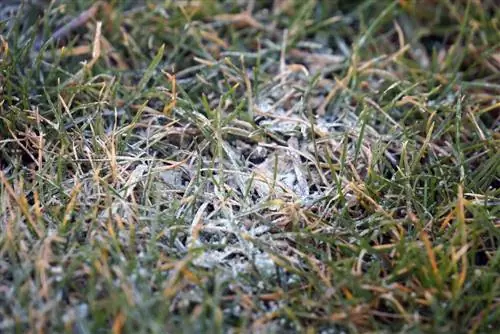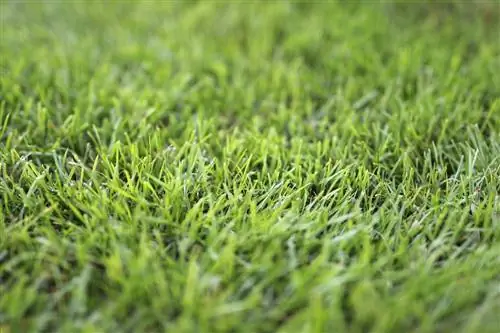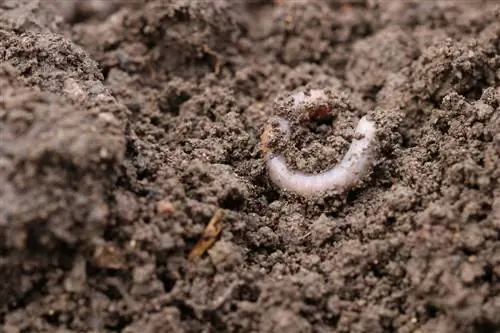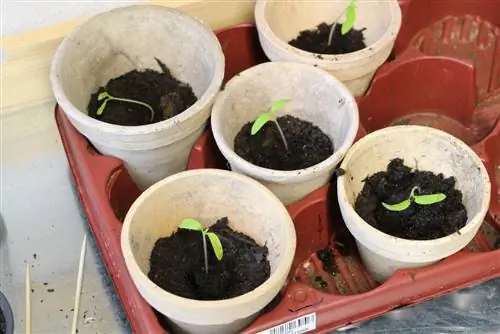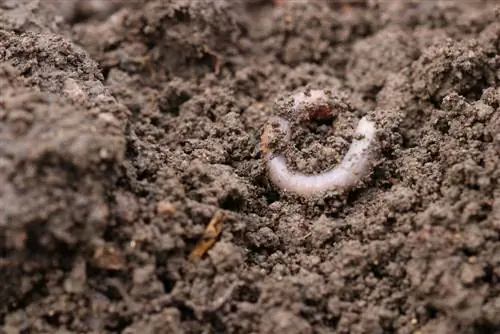- Author admin [email protected].
- Public 2023-12-17 03:39.
- Last modified 2025-01-24 12:45.
There are complex nutrient dynamics that take place in the garden soil system. He althy growth of plants depends on a balanced balance of main nutrients such as nitrogen, phosphorus and potassium as well as numerous trace elements. Unfortunately, the symptoms of nutritional deficiencies and excess nutrients are similar. If fertilization is carried out according to the motto, 'a lot helps a lot', an undersupply will simply tip the scales in the other direction without finding a solution. Instead, prudence is required. Read here how over-fertilization affects the soil with information about signs and consequences for plants.
Causes of overfertilization
It is an irrefutable fact that the soil in the majority of ornamental and kitchen gardens is over-fertilized. This applies to both private and commercial areas, with fatal consequences for our he alth and the environment. The question of the cause is difficult to answer in one sentence and requires a look back at historical development.
The long path from manure to complete chemical fertilizer
For plants to thrive, good soil, enough water, air and sunlight are not enough. Only a balanced combination of nutrients and trace elements ensures vital, he althy growth. Where the availability of nitrogen, phosphorus, potassium and other minerals is limited, the entire ecosystem suffers, causing entire cultures to collapse throughout history. Since the invention of agriculture, farmers and gardeners have tried to counteract a lack of nutrients. Until the 19th century, soil fertility was promoted with the help of organic fertilizers such as bone meal, stable manure and horse manure. Methods were also used, such as crop rotation, supplemented by optimized equipment and machines. In fact, steadily higher yields were achieved, so that there was enough food available despite the growing population.
This development changed dramatically around 1840, when Justus von Liebig came onto the scene. In his opinion, it was sufficient to supply the soil with a sufficient amount of inorganic nutrients to promote plant growth at will. Unimagined increases in yield were now within reach. Natural methods such as crop rotation and the use of organic fertilizers were suddenly no longer considered modern enough. Instead, a development began, culminating in the invention of complete chemical fertilizer. Today, hundreds of tons of industrial fertilizer end up in the environment every year, a large part of which ends up unused in deeper layers of soil, in groundwater and drinking water, in biotopes and into the air through outgassing. We are all familiar with the consequences under keywords such as 'acid rain', 'decline in biodiversity', 'overturning of water bodies' or 'greenhouse effect'. The use of blue grain, dicamba and other purely chemical fertilizer preparations is increasingly falling into twilight, but still takes place in private and primarily commercial cultivation.
Overfertilization and deficiency go hand in hand
In view of the development shown, simply stopping all fertilization now turns out to be a fallacy. In fact, an oversupply of nutrients is always accompanied by a deficiency of other minerals. If a plant lacks nitrogen, an excess of potassium will not help it. On the contrary, an excess of certain substances reinforces the undersupply. A classic example is the excess of lime in the soil of plants that require an acidic pH value. The excess of lime blocks the path of iron into the plant pathways, which is actually naturally present in sufficient quantities in the soil. The result is life-threatening leaf chlorosis. In order to save the affected plant, the over-fertilization with lime must be revised and immediately available iron should be administered at the same time.
Signs and consequences for plants
The optimal supply of nutrients to ornamental and useful plants is one of the central challenges in hobby gardening. An important step on the way there is the correct interpretation of the signs of over-fertilization of the soil in order to initiate appropriate measures. For your orientation, we have compiled typical symptoms for you below, with information about the consequences for the plants and tips for solving the problem:
Nitrogen overfertilization
Signs
- Soft, spongy shoots
- Increased linear growth
- Soft leaves that turn blue-green or fade
- Leaf edges curled downwards as it progresses
- On potted flowers, the lower leaves turn yellow with brown edges
Follow
- Increased sensitivity to frost
- Increased infestation with pests, especially aphids, spider mites, cicadas
- Increased occurrence of fungal infections, such as mildew, gray mold and stem rot
- Increased susceptibility to gum flow on stone fruits
- Reduced storage life of fruits and vegetables
In addition, over-fertilization with nitrogen depletes the potassium present in the soil. As a result, you are confronted with a typical deficiency of a specific nutrient as a result of an oversupply of another nutrient.
Tip:
Consistent mulching with straw helps to eliminate over-fertilization with nitrogen in the long term, as the straw attracts and binds the nutrient. The administration of the plant tonic Mr. Evergreen Flora also provides relief. In addition, the water leaf plants of the genus Phaecila - also known as bee friends - remove harmful nitrate from the soil; sown as green manure on the over-fertilized area.
Phosphorus overfertilization
Signs and consequences
An oversupply of this nutrient does not cause any immediate symptoms, as is the case with nitrogen. Rather, too much phosphorus has an indirect effect. Overall, growth disorders occur because important trace elements such as copper and iron can no longer be absorbed by the plant. If you suspect over-fertilization with phosphate, only a professional soil analysis from the special laboratory will provide more precise information.
Tip:
One of the main causes of phosphorus over-fertilization is the excessive use of blue grain. In addition, the concentrated administration of bone meal is responsible for the deficiency. Therefore, switch the nutrient supply to a low-phosphate, mineral-organic fertilizer and no longer use bone meal.
Potassium overfertilization
Signs
- Leaf edge necrosis
- Root burns
- Leaf damage
- Stunting
Follow
- Growth inhibition due to reduced absorption of calcium and magnesium
- Destruction of the fine crumb structure in the soil as a result of the displacement of calcium ions
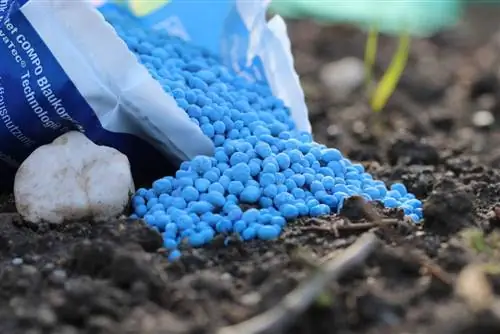
Overfertilizing the soil with potassium rarely has serious consequences for the plants. Due to its mobility, potassium is easily washed out by rain and as part of irrigation measures. In addition, the only potassium available to plants is that which is stored on the outer layers of the clay minerals in the soil, while the ions located between the layers cannot be absorbed. The more clay the soil, the lower the risk of an oversupply of potassium.
Tip:
In very light, clay-poor soils, it is worth investing in a cost-effective Primus Kalitest from Neudorff before you take measures to prevent over-fertilization with potassium. If your suspicions are confirmed, we recommend repeatedly applying low-potassium, magnesium-rich rock powder.
Calcium overfertilization
Signs and consequences
- A pH value greater than 8
- Yellow-green leaf discoloration
- Calcareous soil
- Leaf chlorosis
- leaffall
These are primarily ornamental and useful plants that prefer an acidic environment and are affected by calcium over-fertilization. Rhododendrons or hydrangeas will fail within a short period of time if the soil is oversupplied with this nutrient. As the soil continues to rise, even lime-loving plants react to the excessive supply with the above-mentioned signs.
Tip:
The regular application of acidic leaf compost makes an effective contribution to eliminating excess lime in the soil. In addition, from now on you should not use hard tap water, only soft rain or pond water. The incorporation of peat also has a lowering effect on the pH value.
Magnesium over-fertilization
Signs and consequences
Diagnosing magnesium overfertilization is difficult even for experts because there are no immediate symptoms. First and foremost, the closely linked relationship between magnesium and calcium becomes unbalanced. The excess supply of magnesium blocks the availability of lime, so that we are again dealing with a typical consequence. The result is damage to the roots of those plants that rely on an adequate supply of lime. At the same time, too much magnesium inhibits the plant's access to the main nutrient potassium, which significantly impairs frost resistance.
Tip:
As practice has shown, magnesium over-fertilization usually indicates an oversupply of the soil with other nutrients and trace elements. The administration of magnesium-containing complete fertilizers should be avoided immediately so that the problem can be regulated through leaching over the next few years. Incorporating 3 liters of compost per square meter of garden soil completely covers the nutrient requirements during this phase.
Conclusion
Extensive use of industrial fertilizers has led to an oversupply of nutrients, counteracting the ultimate goal of improved plant growth. In addition to the disastrous consequences for the environment and he alth, over-fertilization of the soil paradoxically also causes reduced growth and other typical deficiency symptoms. Simply stopping all fertilizer administration is therefore not a solution. Rather, conclusions should be drawn from the recognizable symptoms about the ideal composition of the nutrient supply in the hobby garden. The signs listed here can serve as a guide for you to minimize the negative consequences for your plants and to reverse them with the help of our tips.

